1. Aggression, the main theme of the book, is by Lorenz regarded
as one of four fundamental drives. This view may however be questioned.
Basically, aggression is here proposed to have
its root in the division of life on single individuals, in the "principle
of individualization" – and to arise from the conflict between the
primary binding entirety force within one individual and the same
force between individuals of narrower or wider range, ultimately with
a common origin.
More about aggression below.
2. The concept "instincts" has been replaced by the word
ground plans. Lorenz uses the term "drive". He describes behavior
patterns of mostly birds and fishes as less or more ritualized motor
patterns and in terms of directions, which are interpreted in terms
of affects. It invites a comparison with the pure geometrical views
in the dimension model.
With the hypothesis here that such an elementary
structure of rules is a factor underlying the processes of mutations
and ’natural selection’, the primary dimensional aspects and forces
from inorganic levels can be seen as more and more "charged" with
mental meaning and "motives" on superposed levels of life.
3. The eye and cortex of the brain analyze visual impressions
into simple geometrical elements and direction of motions and combine
these elements to complex pictures in the sensory system:
 Fig
Eth-1 Fig
Eth-1
There are for instance cells sensible for direction of linear structures,
others sensible for round forms, others for curves, convex or concave,
others for straight lines in different angles, others for motions
of geometrical elements in certain directions. (Cf. in the model:
direction outwards/inwards, radial/circular
structure, concave/convex, lines, motions.)
Hence, inherited characters in behavior patterns
can be suspected as a correspondence in the motor circuits of the
nervous system – with motions as structural elements.
4. Nest building at reproduction:
Nest building appears as the most typical center – anticenter structure,
a polarization of the whole, dimension degree (d-degree) 5, in poles
0 and 00 in our model – either it concerns a cavity in the sea bottom,
a cave or hole or a bird’s nest.
The offspring is the center pole as embryos in
relation to the adult and to the nest or hole, a picture of anticenter
in the dimension of space. The parents get the role of primary complementary
counterpart and anticenter to the offspring: protecting, brooding.
Cf. mouthbreeders among fishes or the bear mother bent around sucking
cubs.
 Fig
Eth-2-201-1 Fig
Eth-2-201-1
When feeding the offspring (of birds or mammals)
the outer geometry between the individuals is inward, convergent
direction of parents towards the center in the young and the outward,
divergent direction of the youngsters’ open mouth gaps:
 Fig Eth-3-201-2 Fig Eth-3-201-2
Within each individual as a whole the directions are reversed:
outwards from the feeding parent, inwards the mouth of eating youngsters.
However, only at identification. This could be translated to parents
feeding themselves, their inner emptiness after the birth of the
offspring.
When there is no identification, the youngsters
can be pecked to death, other mothers eat them up. The inward direction
of the parent takes the form of aggression.; "that something" in
the parent’s nest seems perceived as if it had stolen the parent’s
own center, its real source for a self.
Identification could be described as passing through
the underlying level as binding force according to postulated definitions
in the dimension model. For birds it’s the youngsters’ chirps that
activate this communication canal, but Lorenz describes the
chirps as signals for inhibition of aggression.
 Fig
Eth-4-201-3 Fig
Eth-4-201-3
5. Territories:
The surrounding are of course the opposite, complementary pole
for each living organism, its anticenter on the most underlying
level. For animals that uphold territories, these means preserves,
a "pantry" – in this sense a parallel for instance to the yolk in
a bird’s egg.
Many species of fishes have the need for a territory
only during the reproduction period, a demarcation as of an invisible
cell membrane.
The bigger entity: individual – own environment
in uphold of a preserve could be said to have a similarity too on
the microscopic level of fertilization with the completion of a
haploid sex cell to a diploid, self-sufficient one. (Cf. certain
insects where the females eat up their male mates!)
Anticenters = 00-poles debranched and meeting "the other way around"
on superposed levels:
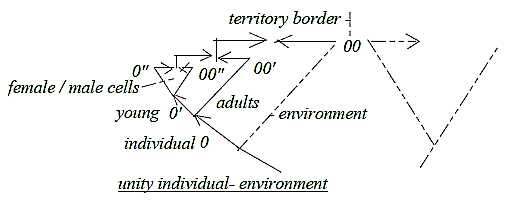
Fig
Eth-5-202-1
Border between territories as a kind of "circular" structure becomes
defined by the relation between opposite forces as two-way directed
vector fields around the individuals: in Lorenz’ terminology
where the "aggression" outwards turns to "flight" inwards; center
= c, anticenter = ac:
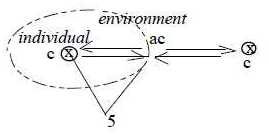 Fig
Eth-6-202-2 Fig
Eth-6-202-2
6. Herd animals versus territory upholding animals:
A first opposition is of course the one between plant-eaters
and predatory species. It’s a question of levels of nourishment:
plants → ←
grass-eaters → ←
predators.
From the viewpoint of nourishment from the environment,
predators represent of course as subjects the 0-pole, while the
grass-eater victims is only surrounding pantry, as such representing
the 00-pole, a plenty – like grass for grass eaters.
From the viewpoint of individuals and dependence,
it’s the reverse: predators represent the superposed level and in
that sense a class of lower d-degree, anticenter in relation to
those who can live on more fundamental food.
Spatially it can be seen reflected in the way
predators as lions for instance hide at the border of a field with
grass-eating herds. Or in the way a group of sharks surround and
crowd together a shoal of fishes.
Hunting for food is not by ethologists regarded as aggression,
even if implying cruel murder. Hunger is an inward directed component
of "self-preservation", similar to certain forms of aggression,
but is obviously a more elementary force and a relation between
subject and object, not two subjects.
One aspect is perhaps that during hunting the
predator and its fleeing target animal have principally the same
direction in outer motion, while "aggression" may be said to imply
different kinds of counterdirections.

Fig
Eth-7-206
There exists a differentiation too among species with similar nourishment
as the one between shoaling fishes and solitary poster-colored fishes.
This opposition is in the book explained only in teleological
terms, as adaptation to different purposes: uphold of territories
should favor spread of the species, while shoals give less risk
to be the selected victim.
Yet, regarding the roots and causes
for the differentiation, it seems necessary to count on 2 opposite
forces, a binding, integrating force (from 0-pole in our model)
that is dominating among shoal fishes, and a polarizing, splitting
force (from 00-pole) as dominating among the solitary poster-colored
fishes. Cf. among unicellular organisms those forming colonies and
those more solitary ones.
It should be said that Lorenz in other contexts
stresses the need of both causal and final (~ teleological) explanations
and that these don’t exclude one another.
7. "Aggression":
In point 1 above aggression as such was suggested as
arising from the conflict between the entirety force (d-degree 5
in our model) in the individual as a unit and the same entirety
force within a group or "the whole" in narrower or wider sense.
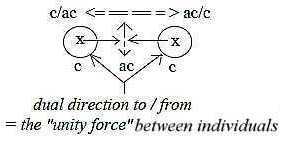 Fig Eth-08-a Fig Eth-08-a
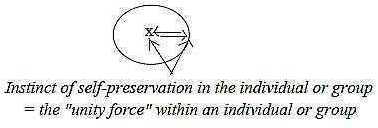 Fig Eth-08-b Fig Eth-08-b
In reality a straightforward conflict often very clearly reveals
an urge for depolarization, e.g. in terms of (re-)establish equality,
out of the binding force between individual units.
One factor is the need to get confirmed to use a term from
modern psychology, from outside, from other subjects - since
each individual is always only half of the world. It’s a need for
the "I" to get confirmed from others to become saturated to a
"self". Cf. children’s need to be seen and rivalry among them.
Hence, aggression seems to include a need of confrontation,
to meet: 0→ ←
0, the same outward directed force of the "I" in others answering
their own.
A depolarization between individuals is only indirectly
possible. The binding force between the individuals can only be
expressed in more or less symbolic behaviors as paralleling (as
chromosomes position themselves parallelly for crossover at fertilization),
in exchange of food and other rituals.
The urge for confrontation gets a character of
aggression owing to this bar to depolarization, different kinds
of "aggressions" are born out of this very conflict.
However, when the divergent force in subjects as saturated "selves"
meet the same forces in others, the confrontation actualizes the
opposite force repulsion - an anticenter (00) in terms of the dimension
model. Position of the selves are at their surfaces, their outer
border. Then their inward direction - a primary polarizing force
- is brought up to the fore. It's one pole of the self-preservation
"instinct", the entirety force within the individual
or "we-group". The opponents have both directions outwards/inwards
in themselves.
It implies anti-identification, a pushing
away and expelling (either it gets the character of fear or something
else, depending on power): 0 ← 00 →
0.
 Fig
Eth-9 Fig
Eth-9
Biologists often talk about a drive to spread the species, which
may be only a name for the geometrically given divergent vectors
in subjects as 0-poles seen as an expansive force.
Cf. animal males’ fights in the time for
reproduction, the inward directed force of males.
The demarcation of a "we-group" or of the individual
"self", establishing borders as such, with exclusion of
some others, may be interpreted as one strategy for solving the
underlying conflict between the binding forces on different levels.
A more or less conscious limitation of the own world. (For an individual
self, this stress of a demarcating border implies anchoring the
foothold of his identity at his surface.)
One expression is of course defense of territories,
borders as equivalent with "skin".
8.. "Inhibition":
Lorenz describes the two forces outwards/inwards
in our model as aggression and flight and that the "conflict" between
these opposite forces leads to behavior patterns seen as inhibition
of aggression: the frontal attack restrained by resistance to hurt
a ’kin male’ of the same species. Thus halfway between an antiparallel
and a parallel relation.
What he describes in terms of "aggression", "inhibition" and "redirection"
with the emphasis on directions may as well be read in terms of
relations between outward and inward directions as forces and their
appearance as derived forces in different angle steps of lower d-degrees,
this using aspects from the dimension model.
The author stresses that this inhibition and reorientation of aggression
are equally active forces as the aggression itself. Yet, he regards
them as a new "independent" force, an independence it has not in
our model.
It may in this model be described as a step from
the antiparallel angle in d-degree 4 to the perpendicular one of
d-degree 3, a purely dimensional geometry underlying this motor
patterns.
Broadside display of males to impress on the "rival" is one typical
example:
- 4th d-degree: Antiparallel confrontation in males’
duels for instance.
- 3rd d-degree: Broadside display, impressing: body at
straight angle to the confrontation axis and the adversary. In our
model it’s the assumed angle of "90o" in d-degree 3,
(according to Lorenz it’s "possibly" half a turn away from the antagonist,
motivated by a reaction to flee.)

Fig Eth-10-203-1
(Sketches to the right in this figure a try to illustrate further
steps: "reorientation" and paralleling in positions, see below.)
Already in males’ antiparallel, frontal threatening positions as
at dueling, in their demonstration of strength, a potential perpendicular
axis is marked.
In mouthbreeders for instance the frontal attack
is braked at the same time as they increase their cross-section
and covers of gills and other flaps of skin are spread out.
Males of fallow deer in frontal meeting wave their
heads laterally.

Fig Eth-11-203-2
In the broadside exhibition the whole body position has
been turned to perpendicular. It’s a demonstration of size but could
also illustrate an excluding wall, a border.
The lateral coordinate axis in these "inhibiting" relations
corresponds obviously with the same development of inhibiting networks
in the nervous
system, through lateral connections via intermediate nerve
cells.
The motor cortex of the human brain is said to
fill mostly inhibiting functions, while deeper centers send the
primary motor signals. It shows on the factor of inward direction
in inhibiting behaviors - departing from anticenter – as cortex
in relation to the deeper centers.
9. "Redirection":
This redirected behavior appears when there already is some
kind of bond between two individuals, as between mates. Compare
the sexual complementarity out of a polarization from an underlying
unity.
One example: At threat, a male in a species of
Cichlids swims first straight on towards the antagonist and turns
then to broadside display.
When the fish instead swims "expressly" past the
other individual, a mate, and shows the broadside-impressing behavior,
it symbolizes that the partner is not the target for attack but
somebody else in the fish’s movement direction. Inhibition of aggression
has gone one step further – possible to interpret as in a new angle,
closer to what here is called paralleling as a certain degree of
identification.
 Fig
Eth-12-204 Fig
Eth-12-204
This reorientation behavior has later got the role of what is called
a ceremonial greeting.
10. Paralleling– Personal bonds:
Personal bonds are only found among species of bony fishes,
birds and mammals. Hence, it appears as a step in faculties following
with the evolution of new classes within subphylum Vertebrates.
In the examples that Lorenz gives on behaviors
where personal bonds between individuals or within a group have
been developed, both factors of confrontation direction to a center,
→ 0 ← and directions
outwards, ← 00 →,
appear, possible to interpret as two-way direction as of d-degree
4 in our model: <=========>. Yet divided a) in different moments,
b) different parts of the bodies. It results in a partial paralleling
of motions, in triumph ceremonies but also in common threats towards
some more or less specified excluded "others".
In the confrontation (meeting) moment, → 0 ←, wild ducks the male turns his head backwards from
his mate the more he gets sexually excited, that is to say parallel
to her direction of movement.
In what is called "ritualized inciting" the female
meets the mate frontally but the head is turned threatening backwards
over the shoulder towards the "enemies" as showing the mate which
others to attack, i.e. in the same direction as that of the mate.
We have in these examples the opposition between body and head.
The opposite directions "inwards" of the mates’ bodies could be
said to express the complementary, sexual polarity, while the heads
backwards as "outwards" from this center expresses an identification,
a common center.
The two-way direction of personal bonds is further polarized in
different moments In the confrontation which define a common center,
? 0 ?, the behavior
becomes transformed to a greeting ceremony but only before or after
moments of anti-identification with others, a "reoriented"
aggression of threatening in Lorenz's description.
In the geese’s triumph ceremonies the necks are normally
stretched upwards, i.e. parallelly, after a threat directed outwards
another individual or only out in the air (as outward direction,
divergence, pole 4b in the dimension model).
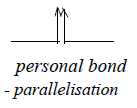 Fig
Eth-13 Fig
Eth-13
Or the whole flock of geese threatens another group with necks
parallelly stretched out. The shared direction marks that the individuals
have a kind of common center, a sense of common origin; the behavior
seen as a geometrical design of identification.
In these different moments of behavior we can
find a d-degree step 4 - 3, between principally vertical and horizontal
directions, between antiparallelity and the polarity circular -
radial of d-degree 3. Cf. that the necks of a flock of geese when
threatening is described as convergent, convergence from inward
direction.
This paralleling of social behavior reveals the integrating force
within the individual widened to the whole group, less or more extended
in definition and demarcation of what is "the group". A stepwise
deeper, more including "We" appears as expression for the
underlying binding forces.
The observations that paralleling as marking a common center always
seems to demand the activation of an anticenter agrees with the
abstract principles of a dimension chain. It could be interpreted
as just the divergent urge to confrontation as such, (for virtual
new centers).
11. Submissive behaviors - Ranking orders:
Submissive behavior get the function of inhibiting aggression
between two adversaries in Lorenz's description. The similar behavior
appear as establishing ranking orders in groups.
Submissive, appeasing behavior can according to Lorenz be
derived from the "infantile" behaviors of youngsters versus adults
but appear also in the mating behavior of females.
According to him the behavior in its actual form
has "nothing to do" with childishness or sexuality. Yet, the complementarity
between sexes takes during evolution the outer structural form of
inward direction from males (from anticenter, the 00-pole) and the
outward direction of females (from center, the 0-pole).
All submissive behaviors imply that the individual turns its weapons
away as Lorenz describes them.
Gull birds turn the vulnerable back of their heads
towards the other gull, other animals turn the back parts of their
bodies, other their ventral side upwards or just taking a lowered
and contracted position. All these different ways to deny confrontation
can be interpreted as showing the attitude of a lower, deeper 0-pole
in relation to the other individual, thus confirming the other's
might.
We could remember the very first poles of an embryo,
the vegetative 0-pole in relation to the animal 00-pole, the ventral
side invaginating to inside layers (inducing the neural tube) and
in a later step turned to the back part of the body.
Submissive behavior between two individuals and ranking order within
a group are both to other strategies (besides demarcation/exclusion)
for solving the fundamental conflict between binding forces. They
rely on the polarization of 5-dimensional units into complementary
poles: a division in opposite but complementary roles, expressed
in terms of the dimension model. In this sense it implies a derivation
to lower d-degrees of the individuals.
Cf. submissive attitudes with the b-poles from 0-pole in relation
to a-poles: outward direction versus inwards, radial structure versus circular, inside or concave versus
outside or convex surface, motions from each other versus to each
other.
In a ranking system the individuals get mutually opposite roles,
"haploid" ones with a biological term, which means roles as halves
of their selves. This refers to each special situation and confrontation.
The role can of course change towards different other individuals
depending on rank.
Upward – downward directions are marked quite
physically as described above, upward direction in submissive behavior,
lowered position, turning of the ventral side upwards and such things.
While the individual with higher rank takes up the superior position
and is turned downwards.
When the group is threatened, the youngsters representing
the 0-pole are gathered inside, in the center, the strongest females
or males anticentric around them (as the 00-pole), forming a ring,
a periphery as a wall (a surface).
Aggression is said to increase with higher age and rank. One aspect
in this is that upward direction corresponds to divergence and therefore
at bottom derives from a common center, which represent kinship
and affinity. While downward – inward direction from the periphery
implies vectors with separate origins and represent the totalitarian
(gathering) force, opposite the integrating one.
The highest in rank gets the role ("liability")
of the inward directed component in self-preservation of the group.
A ranking order implies naturally reduction of both parts in the
confrontation, of outer or inner sphere of the "selves".
A separation however gets inevitably more severe for the upper,
dominating part. Cf. Exogastrulation (file Embryology,
No. 4.)
END
(The level of Biology is followed by the level of Psychology.
The authors book "The I and the Ego, Psychogeometry"
may be mentioned here, however so far only available in Swedish.)
|
 Fig
Eth-2-201-1
Fig
Eth-2-201-1 Fig Eth-3-201-2
Fig Eth-3-201-2 Fig
Eth-4-201-3
Fig
Eth-4-201-3
 Fig
Eth-6-202-2
Fig
Eth-6-202-2
 Fig Eth-08-a
Fig Eth-08-a Fig Eth-08-b
Fig Eth-08-b Fig
Eth-9
Fig
Eth-9

 Fig
Eth-12-204
Fig
Eth-12-204 Fig
Eth-13
Fig
Eth-13